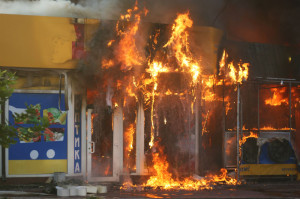 Fire safety is more important in a grocery store than you think. Grocery and convenience stores are leading victims of many structural fires, with fire departments responding to over 13,570 between 2009 and 2013. The National Fire Protection Association, in their 2015 Structure Fires in Stores and Other Mercantile Properties, shared some data on the unique risks that grocery stores face from fires. Here are some of the statistics from the report highlighting the fire risk in grocery stores.
Fire safety is more important in a grocery store than you think. Grocery and convenience stores are leading victims of many structural fires, with fire departments responding to over 13,570 between 2009 and 2013. The National Fire Protection Association, in their 2015 Structure Fires in Stores and Other Mercantile Properties, shared some data on the unique risks that grocery stores face from fires. Here are some of the statistics from the report highlighting the fire risk in grocery stores.
- Fires are more common during the day, but property damage is greater at night. Fires between 9:00 p.m. and 5:00 a.m. caused an average of $73,800 of property damage each, while those occurring between 5:00 a.m. and 9:00 p.m. caused an average of $33,900 of property loss each.
- The leading cause of fires in stores is usually cooking equipment, which was responsible for 21% of fires. But fires caused by electrical distribution and lighting equipment accounted for 27% of direct property damage.
- Electrical failure or malfunction is the leading contributor to 22% of fires.
These statistics paint a clear picture of the fire risks that grocery stores face. Cooking equipment is the leading contributor to fires in stores, but those fires tend to be smaller and easier to put out. The fires that do the most damage to the store tend to be caused by electrical malfunctions or failures. Grocery stores have a lot of electrical risks, from the banks of refrigerators to the loads of machinery needed for store operations. These systems significantly strain a store’s electrical system, and when that system malfunctions, it can lead to fires.
In a recent article for SuperMarket News, Tom Parrish, a former firefighter and fire marshal now elected president of the National Automatic Fire Alarm Association, outlines some of the risks grocery stores face. He advocates for centralized systems tracking store fire safety information, including inspection, repair, and work reports. His theory is that by making this information easier to access from a centralized location, stores will be better able to manage their risks or access the data quickly in the event of a fire. It’s an excellent read, especially for store owners with multiple locations configuring a fire safety plan.
Fire safety in grocery stores is a significant concern. Grocery stores are full of flammable materials, and fires can spread quickly when they occur. Preparing a fire safety plan is very important for your store’s safety. But that’s just part of the puzzle for keeping your store safe. There are a lot of other safety and risk factors that store owners need to prepare for. That’s where our compliance, legal, and risk management team can help. We offer a variety of store safety services, including insurance risk management. We’ve partnered with leading firms to provide the best service for our customers so you know that your store is protected in the case of a fire or other catastrophic event. To learn more about these services and how they can help keep your store safe, visit our website!







